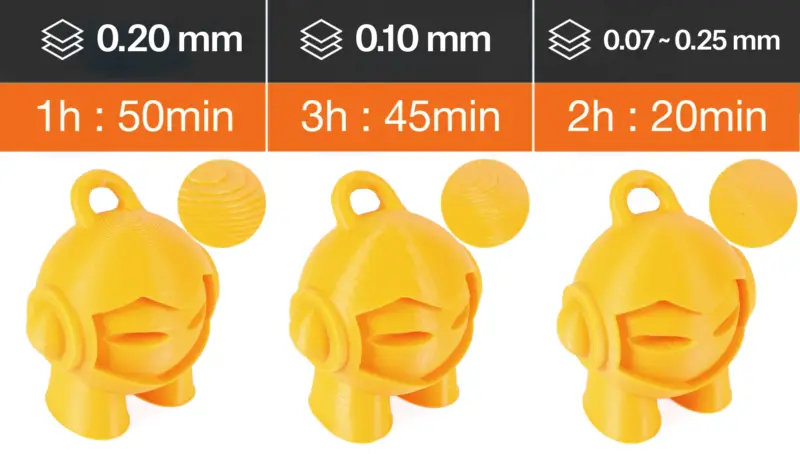Along with layer height in millimeters, another term often thrown around to measure 3D printing resolution is microns. So what exactly are microns, and is 100 microns considered good?
100 microns is the same as setting a 0.1mm layer height in your 3D printer slicer. A 0.1mm layer height will yield a fairly high-quality print and the layer lines will hardly be visible. Most of your everyday printing will be at 200 microns or 0.2mm.
What are microns?
Microns are a very standard unit of measurement used for very tiny measurements. One micron is equal to 1/1,000,000 of a meter, so 1,000 microns is 1 mm.
That’s why most 3D printer layer measurements are in hundreds of microns.
Some 3D printer manufacturers will also list their 3D printer resolution in microns instead of fractions of millimeters.
Remember, just divide the number of microns by 1,000 to get the layer height in millimeters as you would input in your slicer.
Factors that affect print quality
The micron measurement provided by manufacturers refers to layer height. The layer width is usually the same as your nozzle size.
Since the resolution of 3D printed objects is determined by layer height, that’s the number you should pay attention to.
The layer height determines how high each layer is. A layer height of 100 microns or 0.1mm will mean every layer your 3D printer puts down is 0.1mm high.
The average width of a human hair is 100 microns, so you can imagine that an objected with a 0.1mm layer height will not have very visible layer lines.
You can also divide the height of your whole model by the layer height to find the number of layers the model will require.
So if your calibration cube is 20mm tall and you’re using a layer height of 0.1mm, you’ll need 200 layers to finish the object.
Generally speaking, the lower the layer height, the higher the print’s resolution will be.
Lower layer heights(100 microns and below) are also very useful for miniature 3D objects which have lots of intricate details that may be missed out if you print with a layer height too great.
Pro tip: Always set your layer height at 75% or less of your nozzle diameter. Any higher and you risk clogging your nozzle as the printer will try to feed more plastic through than the nozzle is capable of extruding.
So, what’s the best layer height for 3D printing?
If you’re looking to produce high-resolution prints with smooth surfaces and sharp corners, then a layer height of 100 microns is ideal.
For most everyday prints that don’t involve lots of details or tight tolerances, 200 microns or 0.2mm will be just fine.
At a layer height of 200 microns, the height of each printed line would be 0.2mm, which is just right for most 3D printing jobs.
For maximum speed and efficiency, you can even lower the layer height to 300 microns, but that might sacrifice some print quality.
When in doubt, a layer height of 200 microns is a safe bet.

Image credit: Prusa Research
50 vs 100 microns in 3D printing
100 microns yields very nice prints, but do you need to go even smaller to 50 microns?
Improvement in resolution
50 microns is a layer height of 0.05 mm. At this point, you’re really pushing a standard 0.4mm to the limit, so to get ideal results here, you’ll need an even smaller 0.2 mm nozzle.
A 0.05 mm layer height will have layer lines that are even less visible than 0.1 mm, so the prints will definitely look a lot better provided your 3D printer can actually manage to extrude such a thin layer.
Low layer heights might cause under extrusion
One of the most common problems when printing at such low resolutions is the fact that your nozzle isn’t able to deposit enough plastic for each layer. This can result in gaps and holes in your print, and it’s also the main reason why 3D printer manufacturers recommend printing at a minimum of 50 microns.
Shrinking and warping is also possible
Another problem that some people run into when going with super low layer heights has to do with shrinking. You see, if you try to print out a large object on your 3D printer the material will contract the more it cools down due to the layer height being so low.
This can cause parts of your 3D print to warp, and in some cases actually detach themselves from each other.
The bottom line is – yes, you can go with 50 microns when printing with PLA filament on a standard 0.4mm nozzle, but it’s not always the best idea since there are some potential issues you might run into.
Printing time
One huge tradeoff of using very small layer heights is that it takes that much longer to print an object at a high resolution than it does at a lower resolution.
The number of layers doubles every time the resolution is doubled!
An object with a height of 10mm will need 50 layers at 200 microns.
At 100 microns, that doubles to 100 layers.
At 50, that further doubles to 200 layers!
So you’ll have to decide whether you can live with slightly less resolution and a faster print time, or the other way around!
What’s the best layer height for your 3D printer?
Now, if you want to print out hollow or solid prints with no deformation (shrinkage or warping), 100-200 microns is ideal.
When printing tiny objects, go with 50 microns if you’re looking for high resolution prints(and if your 3D printer can pull it off).

